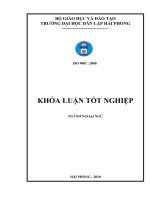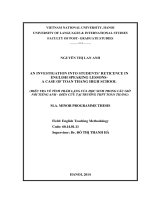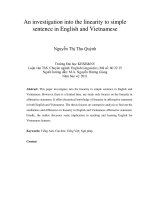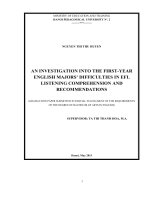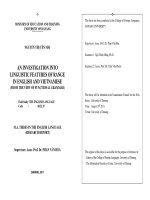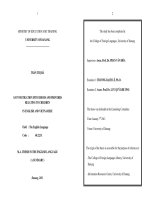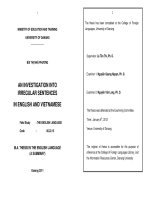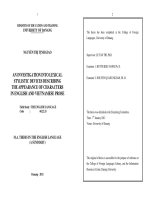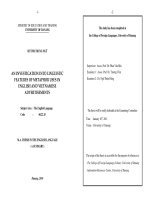An investigation into irregular sentences in english and vietnamese
Bạn đang xem bản rút gọn của tài liệu. Xem và tải ngay bản đầy đủ của tài liệu tại đây (120.08 KB, 13 trang )
1
2
The thesis has been completed at the College of Foreign
MINISTRY OF EDUCATION AND TRAINING
Languages, University of Danang.
UNIVERSITY OF DANANG
Supervisor: Lê Tấn Thi, Ph. D.
BÙI THỊ NHÃ PHƯƠNG
Examiner 1: Nguyễn Quang Ngoạn, Ph. D.
AN INVESTIGATION INTO
IRREGULAR SENTENCES
Examiner 2: Nguyễn Văn Long, Ph. D.
IN ENGLISH AND VIETNAMESE
The thesis was defended at the Examining Committee.
Field Study
: THE ENGLISH LANGUAGE
Code
:
60.22.15
M.A. THESIS IN THE ENGLISH LANGUAGE
(A SUMMARY)
Time: January 8th, 2012
Venue: University of Danang
The original of thesis is accessible for the purpose of
reference at the College of Foreign Languages Library, and
the Information Resources Center, Danang University
Danang 2011
3
4
CHAPTER 1
INTRODUCTION
devices rather than analyses structures of these sentences. Thus, we
focus on investigating into syntactic and cohesive features of
irregular sentences in English and Vietnamese.
1.2 AIMS AND OBJECTIVES
1.2.1 Aims
The aim of this thesis is to investigate syntactic and cohesive
features of irregular sentences, especially fragmentary sentences or
the so-called elliptical sentences without change of speaker in
English and Vietnamese. More importantly, it also finds out and
explains the similarities and differences in the use of fragmentary
sentences in English and Vietnamese to help learners improve their
writing skills as well as in learning and practising irregular sentences.
1.2.2 Objectives
This paper is designed to aim at the following objectives:
- To investigate syntactic and cohesive features of fragmentary
sentences expressed in English and Vietnamese.
- To find out the similarities and differences between English
and Vietnamese fragmentary sentences.
- To suggest some ideas for teaching, learning and
understanding fragmentary sentences expressed in English and
Vietnamese.
1.3 JUSTIFICATION FOR THE STUDY
As we mention above, how to using and understanding
irregular sentences in daily life is the difficulty we can face. The
topic – An Investigation into Irregular Sentences in English and
Vietnamese – is just an attempt to consider problematical aspects of
fragmentary sentences in terms of syntactic and cohesive features.
When we carry out this study, we hope that we will more understand
about ellipsis to analyze and write them well and logically.
1.1 RATIONALE
Language is a special gift of God to mankind. If there were no
language, human civilization would have remained impossibility. It is
thanks to language that we can communicate with other societies and
mix up with them. However, we wonder whether the acquisition of
grammar rules and regulations are necessary and sufficient to make
communication successfully in daily life or not. In fact, we can meet
many unusual structures occurring in a large number of writings.
They can be seen in an advertisement. For example:
[1] Departures from 22 North American gateways.
Connections to over 70 European destinations. Making the world
seem ever smaller.
[25]
It is the fact that irregular sentences perform an important role
in many great works of literature. Take a look at these following
examples:
[2] It's a remarkable case-history. Galloping paranoia.
Delusions of jealousy and persecution. Megalomaniac hatred and
desire for revenge. Curiously enough.
[25]
[3] Today I woke up half a century old. I am not ready. Too
much yet to do. Too much everyday living. Too much left unsaid,
unimagined.
[25]
Besides, in teaching and learning languages, we also meet the
difficulty in explaining some special sentences, which do not follow
predictable grammatical patterns. The explanation nearly pays
attention to authors’ intention in terms of pragmatic and stylistic
5
6
1.4 SCOPE OF THE STUDY
With limited time, space and our own ability, in this thesis we
just investigate syntactic and cohesive features of fragmentary
sentences, the so-called elliptical sentences without change of
speaker, in English and Vietnamese. We also try our best to find out
the similarities and differences of fragmentary sentences in terms of
syntactic and cohesive features in English and Vietnamese and
provide some practical suggestions for teaching, learning and
understanding fragmentary sentences expressed in English and
Vietnamese.
1.5 RESEARCH QUESTIONS
The paper attempts to answer the following questions:
1. What are syntactic and cohesive features of fragmentary
sentences expressed in English and Vietnamese?
2. What are the similarities and differences of fragmentary
sentences in English and Vietnamese in terms of syntactic and
cohesive features?
1.6 ORGANIZATION OF THE STUDY
The thesis consists of five main chapters.
Chapter 1 is the introduction of the study, which includes the
rationale, justification, the scope of the study, the research questions,
and organization of the study.
Chapter 2, the literature review, presents the previous study
related to the paper, the theoretical background of the study in which
it lays emphasis on identifying syntactic and semantic features of
fragmentary sentences.
Chapter 3 is about the methods and procedures of the study. It
will mention the aims, the objectives of the study, then the
methodology, the design of the research, data collection, data
analysis and description of the corpus.
Chapter 4: findings and discussion, is devoted to the analysis
and comparison of syntactic and cohesive features of fragmentary
sentences in English and Vietnamese.
Chapter 5 includes the conclusion and the implications, the
limitations, and suggestions for further study.
CHAPTER 2
LITERATURE REVIEW AND
THEORETICAL BACKGROUND
2.1 A REVIEW OF PRIOR STUDIES RELATED TO THE
PROBLEM UNDER INVESTIGATION
In English, R. Quirk et al simply discussed the device of
ellipsis and indicated their constructions. In 1972, they introduced
shortly the term ellipsis with the same speaker [7, p.75]. Later, in
1985 they classified irregular sentences into sub-divisions and firstly
introduced the term elliptical sentences without change of speaker
which is defined as fragmentary sentences [9, p.849].
Simultaneously, they distinguished fragmentary sentences with
sentence fragments. However, they only gave some examples but not
bring out their specific structures.
In Vietnam, many researchers have been made into elliptical
sentences so far.
Bui Duc Tinh [13, p.349] took interest in Mệnh Đề Tĩnh Lược
in conversation. Nguyen Kim Than [17, p.610 - 613] indicated
generally Cấu Trúc Tĩnh Lược Chủ Ngữ. In the book “Ngữ Pháp
Tiếng Việt” Diep Quang Ban mentioned the concept of Câu tĩnh lược
chủ ngữ [11, p.280] and Câu dưới bậc tương ñương bổ ngữ [11,
p.285]. Tran Ngoc Them also defined irregular sentence as Ngữ Trực
Thuộc in his book “Hệ Thống Liên Kết Văn Bản Tiếng Việt” [18,
p.47].
7
8
Pham Van Tinh, in his book “Phép tĩnh lược và Ngữ Trực
Thuộc Tĩnh Lược trong Tiếng Việt” [24, p.138], dealt with
classification of fragmentary sentences but not gave specific
structures. Le Tan Thi also had a research on ngữ trực thuộc nối, in
which he only focused on fragmentary sentences started with linking
words [21].
There some more authors also mentioned elliptical fragments
in general such as Phan Mau Canh Các Phát Ngôn Đơn Phần Tiếng
Việt [13, p.126], Nguyen Thuong Hung Đối Chiếu Sự Tĩnh Lược Chủ
Đề trong Câu Tiếng Anh và Tiếng Việt [14, p.126-129] etc.
However, the elliptical sentences without change of speaker
which defined as fragmentary sentences has not put into
consideration so far. Our study, therefore, focus on investigating
syntactic and cohesive features of subjectless fragmentary sentences
in English and Vietnamese.
2.2 THEORETICAL BACKGROUND
2.2.1 Definition of Terms
2.2.1.1 Irregular Sentences
According to Quirk et al, the co-authors of the book “A
comprehensive Grammar of the English Language” [p.838], irregular
sentences are some sentences do not conform to the regular patterns
of clause structures or to the variations of those structures in the
major syntactic classes. Simultaneously, he mentioned several ways
in which sentences are irregular. Firstly, they contain forms not found
in regular sentence structures. Second, they are marked as
subordinate. Finally, they are fragmentary, lacking constituents that
are normally obligatory; the ellipsis may be recoverable from the
linguistic form of the sentence or it may be recoverable from the
preceding context. Quirk also divided irregular sentences into 14
types: sentences with optative subjunctive; irregular wh-questions;
subordinate clauses as irregular sentences; adverbials as directives;
aphoristic sentences; subject-plus-complement constructions; block
language; newspaper headlines; personal letters, cables, diaries;
abbreviated sentences in instructional writing; abbreviated sentences
in informal conversation; abbreviated sentences in broadcast
commentaries; elliptical sentences in dialogue, elliptical sentences
without change of speaker (fragmentary sentences).
2.2.1.2 Fragmentary Sentence
Also in their book, Quirk et al advanced the term elliptical
sentences without change of speaker [9, p.838]. Then they
acknowledged them as fragmentary elliptical sentences may occur
without change of speaker or writer He gave examples illustrated as
follows:
a. Two strange figures approached. Martians!
b. Janet felt uncomfortable. Yes, very uncomfortable.
c. It has a very distinctive taste. Crisp and fresh.
d. Designed in Sweden, this teak desk is a terrific buy. Shown
with our exceptionally priced desk chair.
In the book “An Introduction to English Grammar” [3, p.184],
Greenbaum mentioned fragmentary sentences are sentences that are
grammatically incomplete but can be completed from the verbal
context. For example:
e. We’ve made a pact. A new start. No more philandering.
To sum up, base on theoretical background as Quirk et al and
Greenbaum suggested, we take fragmentary sentences that lack of
subject into consideration. Their subjects can be recoverable and are
the same as ones occurring in preceding context.
2.2.1.3 Fragmentary Sentence and Sentence Fragment
When finding and analyzing examples, we find out that
sentence fragments and fragmentary sentences have some
9
characteristics in common. Thus, sentence fragments should be
distinguished with fragmentary sentences in order to specify the
subject of our study.
According to Greenbaum [3, p.184] a sentence fragment is a
set of words that is punctuated as a sentence even though it is not
grammatically and independent sentence.
a. He gossiped about other people’s relationships. And even
his own.
Quirk et al suggest that these fragmentary sentences are to be
distinguished from the sentence fragments that are merely the result
of a punctuation device to indicate a dramatic pause for emphasis.
He exemplified some example of sentence fragments as follows
b. He was drunk. And penniless.
c. We have all kinds of contemporary furniture. For every
room in the house.
[9, p.838]
It is obvious that sentence fragments and fragmentary
sentences have some similar characteristics. They are both not
grammatically and independent sentences. They both also lack of
constituents that are normally obligatory. However, sentence
fragment is occasionally used to suggest an afterthought or a dramatic
pause [3, p.185] while fragmentary sentence is not. As a result, the
ability of their revision is not the same. Take a look at the possible
revision of fragmentary sentences as follows:
d. Two strange figures approached. They are Martians!
e. Janet felt uncomfortable. Yes, she felt very uncomfortable.
f. It has a very distinctive taste. It is Crisp and fresh.
g. Designed in Sweden, this teak desk is a terrific buy. It is
shown with our exceptionally priced desk chair.
10
The examples of sentence fragments cannot be revised as the
same. They can be connected with the previous sentences easily.
h. He was drunk and penniless.
i. We have all kinds of contemporary furniture for every
room in the house.
From these possible revisions above, we can sum up to the
point that although fragmentary sentences may be recoverable from
preceding context but they cannot be connected directly with the
precede sentences as the same of sentence fragments’ revisions.
2.2.2 Halliday’s Theory of Cohesion
2.2.2.1 Halliday’s Theory of Reiteration
According to Halliday’s theory, reiteration is defined as a form
of lexical cohesion. It is related to referring one lexical item back to
another by means of having the same referent in the context of
reference. Basing on the level of generality, Halliday divides the
reiteration into three cases. Firstly, reiteration involves the repetition
of a lexical item at one end of the scale. Secondly, reiteration is the
use of a general word to refer back to a lexical item at the other end
of the scale. Last but not least are a number of things in between – the
use of synonym, near-synonym, or superordinate. In order to
illustrating this point of view, Halliday gives the following examples:
The ascent (1)
The climb (2)
[a] I turn to the ascent of the park. The task (1) is perfectly easy.
The thing (2)
It
(5)
He points out that the ascent, the climb, the task, the thing, it
are cohesive elements related to the lexical item the ascent by means
of (1) the same item repeated, (2) a synonym, (1) superordinate, (2) a
general noun and (5) a personnal reference item. Most gerenal of all
11
12
is the reference item it, the form it comes closest to being an
alternative realization of general noun plus reference item [5, p.279].
In conclusion, reiteration, therefore, includes not only the repetition
of the same lexical item but also the occurrence of a related item.
Any instance of reiteration may be (1) the same word, (2) a synonym
or near-synonym, (1) a superordinate or (2) a general word.
2.2.2.2 Halliday’s Theory of Substitution
As for Halliday, substitution is one type of grammatical
cohesion which is related the replacement of one item by another. It
is also a sort of counter which is used in place of the repetition of a
particular item. As a general rule, the substitution item has the same
structure function as that for which it substitutes. He gives some
illustrated example as follows:
a. My axe is too blunt. I must get a shaper one.
b. You think Joan already knows? – I think everybody does.
From the example above, the author indicates that one and
does are both substitutes: one substitutes for axe and does for knows.
In terms of classification of substitution, Halliday divides the
types of substitution basing on the grammatical function of the
substitute item. This means that there are three types of substitution
which are inclusive of nominal, verbal and clausal substitution.
2.2.2.3 Halliday’s Theory of Collocation
According to Halliday collocation is a form of lexical
cohesion. The lexical items are cohered to each other by means of
their co-occurrence systematically. Halliday give the illustrated
example as follows:
[a] Why does this little boy point wriggle all the time? Girls
don’t wriggle.
From the example above, the author points out that boy and
girl are hardly synonyms, nor is there any possibility of their having
the same referent, they are mutually exclusive categories. Halliday
affirms that there is obviously a systematic relationship between a
pair of words such as boy and girl. The cohesive effect of such pairs
depends on their tendency to share the same lexical environment, to
occur in collocation with one another. To sum up, from Halliday’s
point of view, collocation is a term for cohesion set up by virtue of
the co-occurrence of the lexical items which are related with each
other by mean of a certain meaning relation or simply because of
their sharing the similar context.
2.2.3Tran Ngoc Them’s Theory of Cohesion
2.2.3.1 Tran Ngoc Them’s Theory of Reiteration
Tran Ngoc Them defines reiteration as a type of cohesive
devices which involves the repetition of elements that had before [18,
p.88]. He classifies reiteration into lexical reiteration, grammatical
reiteration and phonetic reiteration. Lexical reiteration, according to
him, is the case in which the lexical item in the latter occurrence is
repeated as the same first occurrence. For examples:
a. Tiếng hát của các em lan trên các cánh ñồng bay theo gió.
Tiếng hát trong như những giọt sương trên bờ cỏ.
b.Đêm nay thể nào hai người cũng sẽ cãi nhau, và Vượng sẽ
ñập vỡ một cái gì ñấy, còn Lành thì khóc. Khóc rất sẽ.
He also supposes that lexical reiteration can be categorized
based on different criteria. With regards to the length of the lexical
item and the repeated item, reiteration can be divided into word
repetition and phrase repetition. As far as the phrase repetition is
concerned, partial repetition and complete repetition are two subdivisions. Based on the part of speech of the lexical item and repeated
item, lexical reiteration can be categorized into the repetition
preserving part of speech and the repetition converting part of speech.
In respects of the function of the lexical item and repeated item, there
13
14
are two types of lexical reiteration: the repetition preserving the
function of the lexical item and the repetition converting the function
of the lexical item.
Besides, grammatical reiteration is rather complex. The
grammatical reiteration, from Tran Ngoc Them’s points of view, is a
type of cohesive device in which the structure of the first occurrence
is repeated in the latter [18, p.93]. He also supposes that grammatical
reiteration consists of two levels: structural repetition and
morphological repetition. Structural repetition involves the repetition
of the first structure in general but not the main structure. Structural
repetition itself can be complete, different, odd or missing. He
exemplified the structural repetition as follows:
c. Nếu không có nhân dân thì không ñủ lực lượng. Nếu không
có chính phủ thì không ai dẫn ñường.
2.2.3.2 Tran Ngoc Them’s Theory of Substitution
According to Tran Ngoc Them, substitution can be defined as
a cohesive device in which the substitute used have the same
meaning or share the same referent with the presupposition [18,
p.114]. For examples:
a. Một cái mũ len nếu chị sinh con gái. Chiếc mũ sẽ ñỏ tươi
nếu chị ñẻ con trai.
b. Phụ nữ lại cần phải học. Đây là lúc chị em phải cố gắng ñể
kịp nam giới.
As noted by him, substitution is also an effective way to avoid
the repetition of the lexical items and make the text more diversity in
lexical use. Thus, the substitution can be recognized easily by
considering whether the pair of cohesive lexical items can replace
each other or not. From this assumption, the definition of
substitution, to some extent, is similar to Halliday’ definition of
reiteration.
2.2.3.3 Tran Ngoc Them’s Theory of Collocation
As suggested in his book “Cohesion in English” published in
992, Halliday uses a term collocation to refer to a form of cohesion
which is achieved through association of lexical items that regularly
co-occur [5, p.284]. In the language of Vietnamese, Tran Ngoc Them
in his book “Hệ Thống Liên Kết Văn Bản Tiếng Việt” published in
1985, advances a term phép liên tưởng [18, p.121]. He defines it as a
type of cohesion that takes place through the fact that a pair of lexical
items is related to each other by sharing a certain semantic relation.
This type of cohesive device is exemplified as follows:
a. Mặt biển mở rộng dần và ñã nối liền lại. Sóng gợn man
mác, cái màu trắng buồn tẻ bao quanh càng man mác hơn.
Obviously, the two linguistics terms have much in common
however it is not the case that there is no difference between the two
terms at all. This opens up the possibility of identifying the
collocation with phép liên tưởng [10, p.28]. As for Tran Ngoc Them,
collocation can be categorized according to the characteristics of the
pair of lexical items and the relation between them. There are two
types of collocation group: identical or unrelated. The identical
group consists of superordinate, chains of collocational cohesion, and
quantitative cohesion whereas the unrelated group contains locatable,
functional, specific and causal.
CHAPTER 3
METHOD AND PROCEDURE
3.1 RESEARCH DESIGN AND METHODOLOGY
This investigation makes use of contrastive analysis in
qualitative and quantitative approaches. Besides, descriptive and
contrastive method helps us to set up the differences and similarities
in linguistic features between English and Vietnamese fragmentary
15
16
sentences. English is chosen as the first language and Vietnamese
serves as the second language.
3.2 RESEARCH PROCEDURE
The following steps will be included:
- Collecting and examining 120 English and 120 Vietnamese
fragmentary sentences.
- Investigating the linguistic features of fragmentary sentences.
- Finding and discussing result of analysis above, compare the
similarities and differences between the two languages.
- Suggesting some implications for teaching and learning
language as well as comprehend and analyze fragmentary sentences.
- Suggesting further research.
3.3 DESCRIPTION OF POPULATION AND SAMPLE
In order to do survey of the population and samples of the
thesis, the study is focused on 120 samples in English and the same
number of samples in Vietnamese. Most of the samples are taken
from English and Vietnamese short stories and novels. They are all in
written form.
3.4 DATA COLLECTION AND ANALYSIS
3.4.1 Data Collection
The relating data in this study is mainly taken from short
stories and novels. The criteria for choosing the data are that they
must be in written form and fuction as fragmentary sentences.
The English samples come from novels such as Love Story by
Eric S., Just Cause by Katzenbach J., Invisible Man by Ralph E.,
Small Vices by Parker R.B., ect. Many samples are also chosen for
English short stories such as An Hour in Paradise by Leegan J., The
Best American Short Stories by Keillor G. and Kenison K., ect.
The Vietnamese samples are picked out mainly from
interesting short stories by writers such as Nguyên Hồng, Nguyễn
Minh Châu, Nguyễn Thị Thu Huệ, Hoàng Anh Tú, Phan Hồn Nhiên,
ect. Some of samples are taken from the novel Cơ Hội Của Chúa by
Nguyễn Việt Hà.
3.4.2 Data Analysis
Data collected will be mainly analyzed on the basic of the
following points:
- Syntactic features: we examine which patterns of structure
are frequently used in fragmentary sentences in English and
Vietnamese.
- Cohesive features: we examine cohesive features used in
fragmentary sentences in English and Vietnamese.
The findings of the similarities and differences of some
features of fragmentary sentences will be discussed basing on the
descriptive and contrastive analysis.
3.5 RELIABILITY AND VALIDITY
The work of comparing and contrasting fragmentary sentences
in English and Vietnamese is mainly based on the analysis of the
collected data in the two languages. Therefore, the process of
reading, choosing and analyzing the samples must be done carefully
to ensure a satisfying reliability of results.
Reliability and validity are two most important criteria to
guarantee the quality of the data collection procedures. Most of the
findings in the study result from the analysis of evidence, statistics,
and frequencies. Therefore, the objectivity of study is assured.
Besides, all the samples are selected from well-known English
and Vietnamese short stories and novels so they are reliable. The
data are then classified based on the theoretical background
mentioned in chapter 2, which can guarantee the reliability and
validity of the research.
In conclusion, all the facts presented above make the study
reliable and valid.
18
CHAPTER 4
DISSCUSSION OF FINDINGS
4.1
SYNTACTIC
FEATURES
OF
FRAGMENTARY
SENTENCES IN ENGLISH AND VIETNAMESE
4.1.1 Syntactic Features of Fragmentary Sentences in
English
4.1.1.1 Verbal Fragmentary Sentences (VFSs)
4.1.1.2 Nominal Fragmentary Sentences (NFSs)
Table 4.2 The Occurrence of Modifiers of Nominal Fragmentary
Sentences in English.
In addition, syntactically, we find that the functions of NFSs in
English are mainly direct object or subject complement.
4.1.1.3 Adjectival Fragmentary Sentences (AFS)
4.1.2 Syntactic Features of Fragmentary Sentences in
Vietnamese
4.1.2.1 Verbal Fragmentary Sentences
4.1.2.2 Nominal Fragmentary Sentences
Table 4.5: The Occurrence of Modifiers of Nominal Fragmentary
Sentences in Vietnamese
Adverb (Phrase)
Adjective (Phrase)
+
_
Postmodifiers
Head
Premodifiers
The Modifications of NFS in English
Noun
Participle
Epithet
Demonstrative
Possessive
+
+
+
_
+
_
+
+
Article
+
Numeral
Quantifier
Ordinal
Cardinal
Postmodifiers
+
_
Ordinal
_
Relative Clause
+
Prepositional Phrase
+
Noun
+
Possessive
Epithet
+
+
Demonstrative
+
Head
Prepositional Phrase
Noun Phrase in Apposition
Numeral
Premodifiers
Relative Clause
_
_
+
+
Non – finite Clause
-ed Participle Clause
-ing Participle Clause
To Infinitive Clause
The Modifications of NFS in Vietnamese
17
Numeral
Article
Cardinal
+
Quantifier
_
+
As far as syntactic features are concerned, the functions of
NFSs in Vietnamese are mainly direct object, adverbial and subject
complement.
4.1.2.1 Adjectival Fragmentary Sentences
4.2
COHESIVE
FEATURES
OF
FRAGMENTARY
SENTENCES IN ENGLISH AND VIETNAMESE
19
20
4.2.1 Cohesive Features of Fragmentary Sentences in
English
4.2.1.1 Cohesive Features of Verbal Fragmentary Sentences
in English
4.2.1.2 Cohesive Features of Nominal Fragmentary
Sentences in English
4.2.1.3 Cohesive Features of Adjectival Fragmentary
Sentences in English
4.2.2 Cohesive Features of Fragmentary Sentences in
Vietnamese
4.2.2.1 Cohesive Features of Verbal Fragmentary Sentences
in Vietnamese
4.2.2.2 Cohesive Features of Nominal Fragmentary
Sentences in Vietnamese
4.2.2.3 Cohesive Features of Adjectival Fragmentary
Sentences in Vietnamese
4.3 SIMILARITIES AND DIFERRENCIES OF FRAGMENTARY
SENTENCES IN ENGLISH AND VIETNAMESE
4.3.1 In Terms of Syntactic Features
As far as the structure of the fragmentary sentences are
concerned, there are some similarities and differences in the
frequency as well as occurrence of types of fragmentary sentences in
English and Vietnamese.
As the table 4.9 shows, we can see that the verbal forms serve
as fragmentary sentences occur with the highest frequency in the both
English and Vietnamese and the nominal fragmentary sentences are
the same. That is to say there are far more common in the use of
VFSs and NFS than in AFSs. The striking difference is that
Vietnamese has higher frequency of AFSs use.
With regards to the structures, from the table 4.2, 4.5, 4.10,
4.11 and 4.12 show, we can see that there are many similarities and
differences in the occurrence of structural types of English and
Vietnamese fragmentary sentences. As for the occurrence of VFSs,
we can see that English VFSs is structured nearly the same as
Vietnamese. However, it should be noted that, there is no appearance
of the structural type V + C in English and the V + O + A
Vietnamese in contrast. The table 4.2 and 4.5 indicate that the
occurrence of NFSs is showing differently in English and
Vietnamese. It is interesting to note that the both English and
Vietnamese NFSs have the great diversity in the use of modifiers.
Nevertheless, their position is not the same; the premodifiers in
English NFSs can be inclusive of article, possessive, numeral,
demonstrative, epithet and noun. The premodifiers of Vietnamese
NFSs, in contrast, includes article, numeral and demonstrative.
When taking these elements into the consideration, we can see that
there is no occurrence of ordinal number modifying the head noun in
both NFSs and the demonstrative appears in English but not in
Vietnamese. Table 4.12 shows that English AFSs are slightly
different from Vietnamese, the structural type of the only adjective
appears in Vietnamese but not in English whereas the structural type
adjective plus prepositional phrase appears in English but not in
Vietnamese.
As far as syntactic features are concerned, the similarities and
differncies of fragmentary sentences in English and Vietnamese are
noted by means of their different functions. In our study, we just take
the functions of NFSs into consideration because of diversified roles
of noun phrase in sentences. As to NFSs in English and Vietnamese,
refer to the table 4.11, we can see that both NFSs can occur as direct
object and subject complement. However, there is a slight difference
21
22
in their syntactic function. The Vietnamese NFSs can function as
adverbial but English NFSs cannot.
Table 4.9 The Frequency of Fragmentary Sentences in English
and Vietnamese
Table 4.12 The Occurrence of Structural Types of Adjectival
Fragmentary Sentences in English and Vietnamese
Types of Structure
English
Vietnamese
Types
Verbal Fragmentary Sentences
Nominal Fragmentary Sentences
Adjectival Fragmentary Sentences
Total
English
63
53%
47
39%
10
8%
120
100%
Vietnamese
65
54%
36
31%
19
15%
120 100%
Table 4.10 The Occurrence of Structural Types of Verbal
Fragmentary Sentences in English and Vietnamese
Types of Structure
English
Vietnamese
V
+
+
V+O
+
+
V+A
+
+
V+C
_
+
V+O+O
+
+
V+O+A
+
_
V+O+C
+
+
Table 4.11 The Syntactic Similarities and Differences of Nominal
Fragmentary Sentences in English and Vietnamese
Function
English
Vietnamese
Direct Object
+
+
Subject Complement
+
+
Adverbial
_
+
The Only Adjective
_
+
Intensifier Plus Adjective
+
+
Adjective Plus Prepositional Phrase
+
_
4.3.2 In Terms of Cohesive Features
When analyzing the fragmentary sentences with respect to the
cohesion, we find that there are similarities and differences in the
occurrence as well as frequency use of the cohesive devices between
English and Vietnamese fragmentary sentences. As the table 4.13
indicates, the forms of reiteration are also mainly used in both
English and Vietnamese VFSs and AFSs. As far as cohesive features
are concerned, NFSs has the most diversity in common use of
cohesive devices. Of all cohesive devices occurring in NFSs, the
collocation has the highest frequency which is refered in table 4.14.
Also in the table 4.14, we can see that the substitution occurs in
English with higher frequency in compared with Vietnamese. The
table 4.15 shows that there are some similarities and differences in
the occurrence of each type of cohesive device used in English and
Vietnamese NFSs. It is clear that all specific kinds of reiteration and
collocation occur in English similarly to Vietnamese NFSs. The
striking difference is that some kinds of substitution which occur in
English NFSs almost do not appear in Vietnamese and vice versa
such as the appearance of synonym and near-synonym, substitution of
pronoun in English but not in Vietnamese or the appearance of
enumeration in Vietnamese but not in English.
23
24
Table 4.13 The Occurence of Cohesive Devices of Verbal and
Adjectival Fragmentary Sentences in English and Vietnamese
Types of Cohesive Device
English
Vietnamese
CHAPTER 5
CONCLUSIONS – IMPLICATION – LIMITATION RECOMMENDATION
5.1 CONCLUSIONS
The research is carried out for the purpose of making explicit
the characteristics of fragmentary sentences in English and
Vietnamese. The description of the structure of fragmentary
sentences plays a significant part in identifying and differentiating
them in the chains of sentences in the text. From a syntactic point of
view, the formation of a fragmentary sentence is similar to a verb, a
noun or an adjective phrase. This relates to the fact that the
fragmentary sentences themselves serve as many function in relation
with sentences they depend on. It can be a predicative when its
appearance as a verb phrases, an object when be shown as a noun
phrase or a complement when its form as an adjective phrase. The
occurrence of fragmentary sentences not only makes the text
themselves more enrich in the lexical and grammatical use but also
brings more background information for the related sentences.
As far as the cohesive features are concerned, it is interesting
to note that the use of cohesive devices in fragmentary sentences in
company with other presupposed sentences is the complex
combination. That is to say there is possibility of the occurrence of
more than two types of cohesion in a same case. The normally
cohesive devices used are reiteration, substitution and collocation.
5.2 IMPLCATION FOR THE LANGUAGE TEACHING AND
LEARNING
As we stated in the first chapter, the fragmentary sentences
used to be thought of not following the grammatical rules so the
language learner can face difficulties in identifying and
understanding their full meaning. Therefore, this study is carried out
Lexical Reiteration
Grammatical Reiteration
VFSs
+
+
AFSs
+
_
VFSs
+
+
AFSs
+
_
Table 4.14 The Frequency of Cohesive Devices Occurring in
Nominal Fragmentary Sentences in English and Vietnamese
Types of Cohesive Device
English
Vietnamese
Reiteration
13
29%
14
39%
Substitution
13
29%
7
19%
Collocation
21
42%
15
42%
Total
47
100%
36
100%
Table 4.15: The Occurrence of Cohesive Devices of Nominal
Fragmentary Sentences in English and Vietnamese
Types of Cohesive Device
English Vietnamese
Lexical Reiteration
+
+
Reiteration
Grammatical Reiteration
+
+
Near Synonym or Synonym
+
_
Superordinate
+
+
General Item
_
_
Substitution
Enumeration
_
+
Substitution of Pronoun
+
_
Substituition by Appositive
+
+
Superordinate
+
+
Collocation Chains of Collocation Cohesion
+
+
Quantitative Collocation
+
+
25
26
with the aim of helping the learners understand the fragmentary
sentences. As a result, the learners can interpret these kinds of
sentences into their native language appropriately. There is no doubt
that the fallacy of the fragmentary sentences is fade away if the
learners of English and Vietnamese give a matter of a complete
thought.
5.3 LIMITATION OF THE STUDY
As we stated in the first chapter, the fragmentary sentences
used to be thought of not following the grammatical rules so the
language learner can face difficulties in identifying and
understanding their full meaning. Therefore, thanks to the similarities
and differences of frangmentary sentences in English and Vietnamese
that we found out, we can help learner understand and can identify
fragmentary sentences easily when practising language skills.
For examples, when reading, learners can answer these
questions:
1. Is this sentence is a fragmentary sentence or a sentence
fragment?
2. What kind of fragmentary sentences is it?
3. What is its subject?
4. What is its function in relation with other sentence?
5. How can it cohere with other sentences?
By answering these questions, learner can understand clearly
the fragmentary sentences they meet and translate them into their
naitive language appropriately.
In practising writing skill, the irregular sentences should be
avoided so far in school. However, in some cases, they are usually
used for special purposes, such as for decorations, for advertising and
so on. Thus, base on our results, learner can know how to write
elliptical sentences correctly. Besides, the cohesive features of this
study can help teacher correct learners’ writing mistakes successfully.
5.4 SUGGESTION FOR FURTHER RESEARCH
From the syntactic point of view, we just concern in syntactic
and cohesive feature at all, thus, other linguistic features of
fragmentary sentences such as semantic and pragmatic features
should be take into consideration to fulfill the complete picture for
the matter. In addition, there is variety of the sample resources that
has not been collected. For example, how to identifying fragmentary
sentences in daily conversations or in prose is a matter for debate.
With respect to cohesive features, as discussed in chapter 4,
one of the significant functions of the general noun is the
embodiment the interpersonal meaning - a particular attitude on the
part of speaker. It is the truth that the analyzing the interpersonal
meaning in company with the use of lexical items in cohesion
function is an interesting subject so far.
